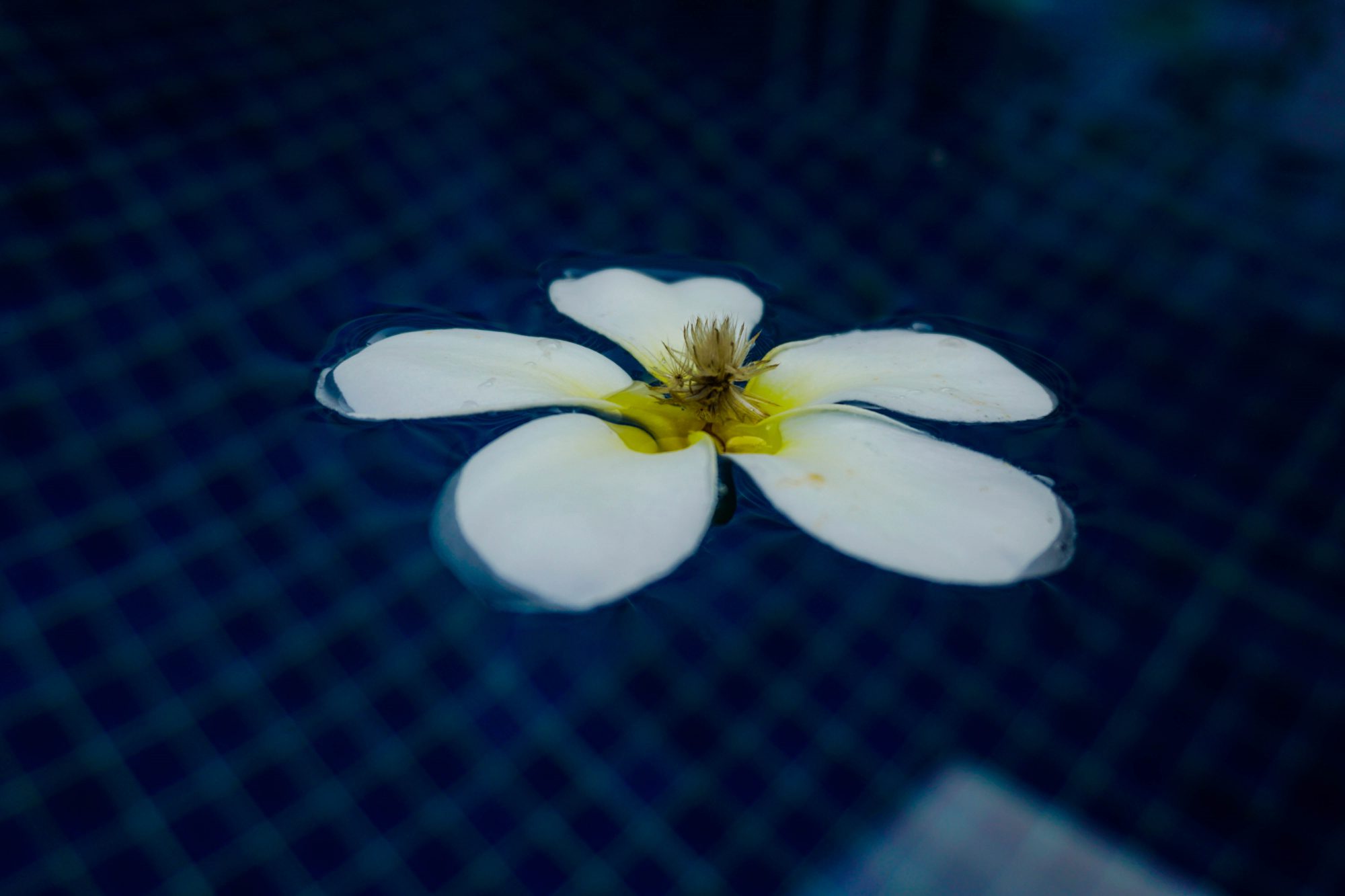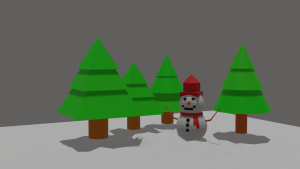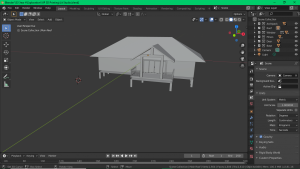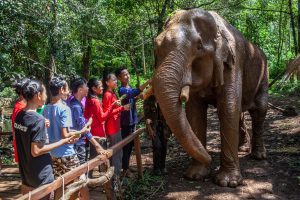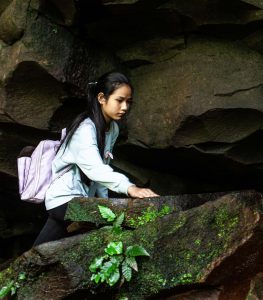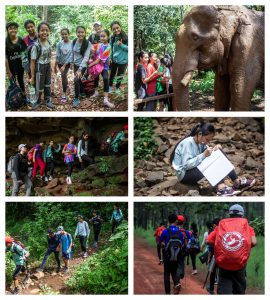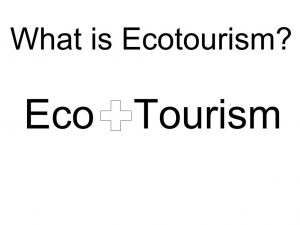VIP Center? It’s an acronym for Visitor Information Palace. Its name said it all. It’s a place where visitors can enlarge their understanding and knowledge about our school. VIP was first created/designed from a container more than 5 years ago. It got pretty old and some things were damaged, so why not have a VIP modification exploration. One of the seniors is helping to facilitate the exploration as well. For your information, a 3D printing of the school’s campus is included in the VIP. We spent the first few weeks just getting comfortable with “blender”; the software we are going to use to design our 3D models. In my opinion, it’s pretty hard, as I’m very new to this. However, I got more comfortable as we started to build our foundations and started designing easier models for practice like snowman. Overall I believe that this is a skill that is very helpful in future needs.
Designing Yearbook

Getting to be apart of creating the yearbook is something that I’m proud to be involved. This is the second yearbook that will be created by Liger students. The first yearbook was created four years ago by the first cohort. As a second cohort, we decided on creating another one that will be a combination of the two cohorts together. Basically a yearbook is a book that is usually packed with images and what we’ve done over the past few years. It’s similar to a look back or throwback or what’s being done. There might be field trips or events that are being featured. Aspects or perspectives of facilitators/staff could also be included. For this particular yearbook, there are more than 20 different sections. There are eight yearbook staff/students who are designing, as well as collecting contents for the book and I’m one of them. Each of us are responsible for three sections in the book. For instance, I’m responsible for collecting content and design the second cohort future predictions, the first cohort essentials and one of the biggest projects in Liger, Liger Marine Research Team (LMRT). It’s definitely a challenge for everyone to gather pictures from the past four years. Moreover, it’s even harder to design the layout for our separate sections, as we want our sections to be entertaining, informational and stylish at the same time. Certainly, we can’t finish the whole book in seven weeks, so we’ll be continuing this exploration later during the year. For this round, we’ve already decided on the color palettes, fonts and the theme, which is jOURney. I hope to continue this project in the near future.
Household Garden
On the 12th of September, we went on a field trip to interview the farmers at Saang district in Kandal province. It’s a village that is the main transport of vegetables to the capital city, Phnom Penh. Although it’s the main vegetable transporter, they grow the vegetables chemically. The goals of the trip were to learn the reasons behind why they are growing the vegetables chemically and to really understand the process of growing using chemicals.
After interviewing about 25 farmers for the whole morning, we found out that there were several aspects behind the reasons of them growing chemical vegetables. The first factor that we identified was high market demands. Despite the fact that the whole village grow a variety of vegetables, the market demands were too high. The farmers mentioned that people love to buy fresh and healthy-looking vegetables, while organic vegetables don’t look fresh all the time and using chemicals could help the vegetables to grow faster and look fresh, which could satisfy the market’s demands on time.
The second reason we found was that the village doesn’t have enough resources to make organic materials needed to grow vegetables such as; cow dung, woody herbs, rice husks, burnt rice husks, different types of land, etc… They said that people used to own many cows, so it was easier to find cow dung, however as time passes, people are modernizing to adapt, evolve and keep up with the technological world. Farmers needed to buy cow dung from others, which costs a lot and it was hard to find the woody herbs in the village as well. Therefore, they have no other choice, but to choose chemical over organic.
The third and last cause is related to convenience and time to maintain the vegetables. To grow organic vegetables, the farmers needed to spend more effort and time on maintaining the vegetables, making sure that there are no bugs eating the vegetables, etc… On the other hand, if the farmers use chemical pesticides or other chemical materials, they put less effort, but the vegetables can still grow fast and ready to harvest on time to satisfy the needs of the markets. In addition, some of the farmers weren’t just only farmers, they also have other occupations to support their family, so they weren’t given enough time for taking care of the vegetables.
Some of my observations from the trip were that there were some farmers who have never tried growing organically, just because no one in the village grows organic vegetables. They don’t want to put the whole vegetable field at risk of not getting high quality vegetables on time. Furthermore, I’ve noticed that the farmers have a lot of experience growing vegetables, but they don’t have a lot of education about why are there more bugs as they use more chemicals. Some of them think that the soil was getting worse, not because of the chemicals, but because of the vegetables that are grown on the field. To maintain the soil, they use crop rotation method. In fact, crop rotation is a great way to maintain the nutrients in soil.
In conclusion, the trip was very successful, as we were able to meet our expectations and get a lot of incredible responses from the farmers, since they were very open. I learnt a lot about the way they use chemical and the changes of the vegetables that are sprayed by chemicals. I can now see a different perspective from the farmers that grow chemical vegetables. I believe that people need to be educated on the effects of chemicals, to stop using chemicals and start growing organic vegetables.
End The Year with Outdoor Leadership
Ending the school year with this Outdoor Leadership exploration is the best way to end it, no doubt. In this exploration, we study about the leadership roles when we are outdoors. Being a leader is not just so other people feared you, but it’s about how other people respect you and recognize you as a leader. A leader is not just someone who tells others their tasks or what they should be doing, but a leader should show and lead the way throughout for their teammates

Some of the things we learned during this exploration are skills to save someone like doing Cardiopulmonary Resuscitation (CPR), checking if the victim is awake or responsive, checking for deformity of the patient, etc… I find it very useful and helpful to learn all these skills at a very young age because with these skills I could actually save a person’s life! We practice with different scenarios throughout the whole exploration and get comfortable doing it. In addition, we learned some of the survival skills while we are outdoors, particularly in the forest or jungle.

In order to practice those skills we went on two trips; one was in Kirirom National Park and the other one was in Mondulkiri. My highlights from Kirirom trip was to see the heaven cliff. I don’t usually get impressed by things easily, but this heaven cliff sure looks like how it sounds like. It was beyond my expectations! It’s like the best place I’ve ever seen. I felt so much better after seeing the gorgeous view of the cliff after a super tiring, long, but chilling weather trek. I’m glad we camp there, but unfortunately, it’s a very short trip. I enjoy it a lot, especially seeing the sunrise in the early morning, including seeing the horn bills.

My highlights from Mondulkiri was overcoming challenges as a whole team. It was very difficult to go to Mondulkiri at the end of May because it’s raining season and our tent ended up all soaked up, so does the clothes that we put there. Everyone shows a lot of caring and sharing for each other while facing this challenge and I love seeing that a lot! We showed a lot of flexibility and adaptation when we changed our plans around. After this struggling experience, we come to understand each other better and become better teammates. Plans might not always go accordingly, so you should always be ready for changes in plans! Even if we are facing the problem, we remain calm and help each other until the end, showing great loyalty to the whole team, not team, but more like a family.
One of the challenge everyone faces during our second trip to Mondulkiri might be the trekking part because it was very slippery due to the rain. There were insects and bugs especially leeches all over the ground. It was very difficult for us to trek when the rocks were slippery and we need to be super careful so that we wouldn’t slip. We collaborate really well when it comes to the steep or slippery ground. We hold hands or give a hand to those who need to climb down or climb up, showing great teamwork, which I find very impressive. We alert each other if there are tree branches or obstacles along the way so that no one would get hurt. One of the best things I observed is how we as teammates encourage each other to push through the hard times they face, for example, some people are afraid of particular insects or bugs, but we didn’t blame them for that, besides we actually help them get out of their comfort zone and push through the struggle together, which results in positive consequences.
We also communicate really well with each other, especially while trekking. We have three signs that we could say out loud anytime we want. “Green light” means go/continue, “Yellow light” means to slow down and “Red light” means to pause/stop. Everyone was very open hearted, whenever anyone needs to stop or pause for water break or someone gets hurt. Talking about water break, we also assigned someone to be a water wizard. He/she needs to make sure that everyone is hydrated and tells them to drink water frequently.
What I thought I could work towards to would be to be a better teammate and nature observer. What I meant by being a better teammate is that I should be better at encouraging and motivating others, like during this exploration trip, I could have encouraged my teammates to continue and push through the tiring trek together, but I didn’t do so. I would love to also openly help anyone in need, especially during the trip because we are at an unfamiliar place that could end up with a lot of struggles. The other thing I could improve on is being a nature observer. I could ask or let my curiosity goes wild about the natural environment. While I was trekking, I didn’t really think much about my surroundings. What I could have done better next time would be to ask questions about the nature around me such as; trees, plants, insects, bugs, wild animals, fruits, flowers, etc…
What is Ecotourism?
Do you know what “Ecotourism” is? Well, if you don’t (even if you do know), this is a place, where you could find out more about ecotourism, a project that I was involved in for seven weeks.
Ecotourism comes from two different words, ecology and tourism. Ecology is part of biology, but in this case, it means living organisms or things related to nature or the environment. Tourism is the act of going on holidays or visiting fun places. Overall, it’s a tour, where you involve and participate in hands-on activities in a community, where you would be in a homestay and doing activities with the local people. An ecotour also includes interaction with the nature, like trekking, etc…
The goal of this project is to create an ecotourism in Bangkern Phal village, Romtum commune, Rovieng district, Preah Vihear province. It’s an indigenous community with about 800 people living there. They have a few hectares of forests as well, which is being preserve and destroy at the same time. Therefore, creating an ecotourism site there will bring more tourists there and people will start to preserve the forests the environment, also their indigenous culture and traditions.
In order to create an ecotourism site, there are so many different things we need to confirm and get done such as:
- The community opinions (How do they feel about having an ecotourism site?)
- The tourists interests (Are they willing to go, if we were to create one?)
- The tour companies (If we create one, will they recommend the tourists to visit?)
Theses are just three main things we need to know, but there are tons more work to get done. For this round, we mainly focus on the market research and the community opinions. That should be the first thing to do as well, because if the community doesn’t agree or doesn’t want any tourists to visit their community, then the project is over and if the tourists aren’t interested, then the project is also over. That’s why these two questions are so important.
After interviewing about 250 tourists in Phnom Penh, more than 80% of them wanted to go. This data shows that this project might have a chance to go on and actually develop the place to be an ecotourism site. We also went on a field trip to the place that we’re planning to create the ecotourism site and they seem to be very happy and interested in this project. In addition, they are willing to help and make this project actually happened.
This round ends with a report, where we write what we did in this round. Next round will be another group of students, where they will study the feasibility of the location. We need to find out about the potentials of the place that we are going to create the ecotourism site, so that will be next round’s main goal. Finally, learning about ecotourism didn’t just teach me about ecotourism, but instead it taught me a whole lot different things like market research and business report proposal.
Take Mistakes as Your Lesson, Not Your Failure
Learning about Khmer traditional food is something that I’m proud of as a Cambodian child. Our goals in this exploration are to gather people’s story about how Cambodian food has impacts on them and to bring back the forgotten food of Cambodia, as nowadays Cambodians tend to have fast foods rather than Cambodian food. After a few weeks of our exploration, we went on a trip to Siem Reap province to interview chefs, small shop owners and local food sellers to get their life’s story and how Cambodian food have influence them. Before we went on the trip, we were assigned into three teams, Journalism, Video and Photo team. I was part of the journalism team and it was a really great experience working as a journalist and I came to realize that being a journalist is like a storyteller. Journalists tell stories, not just reports. They might tell the same story, but in unique and different ways, that’s what I really love about journalists. They also could bring the readers the incident and cause the readers to feel differently about something. Click here to see one of my writing about a Cambodian steam pork bun seller at a local market in Siem Reap province. I am also managing the blog and customize the blog format. Managing a blog for the whole team is very new to me, but I really enjoy doing it and there are some mistakes and struggles, but we use our mistakes as an experience, not a failure.
Creating a Mobile Theater-Round 1
This is the first exploration of my third year, which is called Tos Merl (*Khmer words, meaning,“Let’s watch”) Liger Community Traveling Theater. It is basically about building a community mobile theater. Last year I was in a similar exploration called Set Design, which is about preparing sets for a play, but this is a different kind of experience, since our goal is to make a mobile theater, but we also include the sets in the mobile theater. The reason why we do this is because it is more efficient and it could be used in various ways, meaning we could also use it for classrooms, presentations etc… I was assigned to be one of the two manager of the team, which is a totally new experience for me, since I’ve never been a manager before. After get a taste of it, I really like the job of managing, because this person helps the team a lot, interact with the team a lot, helps keep things organized, on task and keep them excited. Half way through our exploration, we went on a three days and two nights trip to Kampong Cham and Tbong Khmum, province located in the central of Cambodia. The main reason for us to go there is to interview people in the rural areas about their experiences with mobile theater or a play. We also filmed their answer, so that we could make a video and post it in Kickstarter, a website that we use to get donations, to buy the container truck, in order to redesign the truck into a mobile theater. On the other hand, we also performed an educational play to those people without our mobile theater, to introduce them to what is a play and what it looks like. It was a very fun experience for me and my teammates to interact with the villagers and get to know them more. This exploration is probably one of the biggest exploration this year, so we will continue this exploration in round 3 or later. I really enjoy working with my teammates and hope to collaborate with them in the future to finish our mobile theater.
